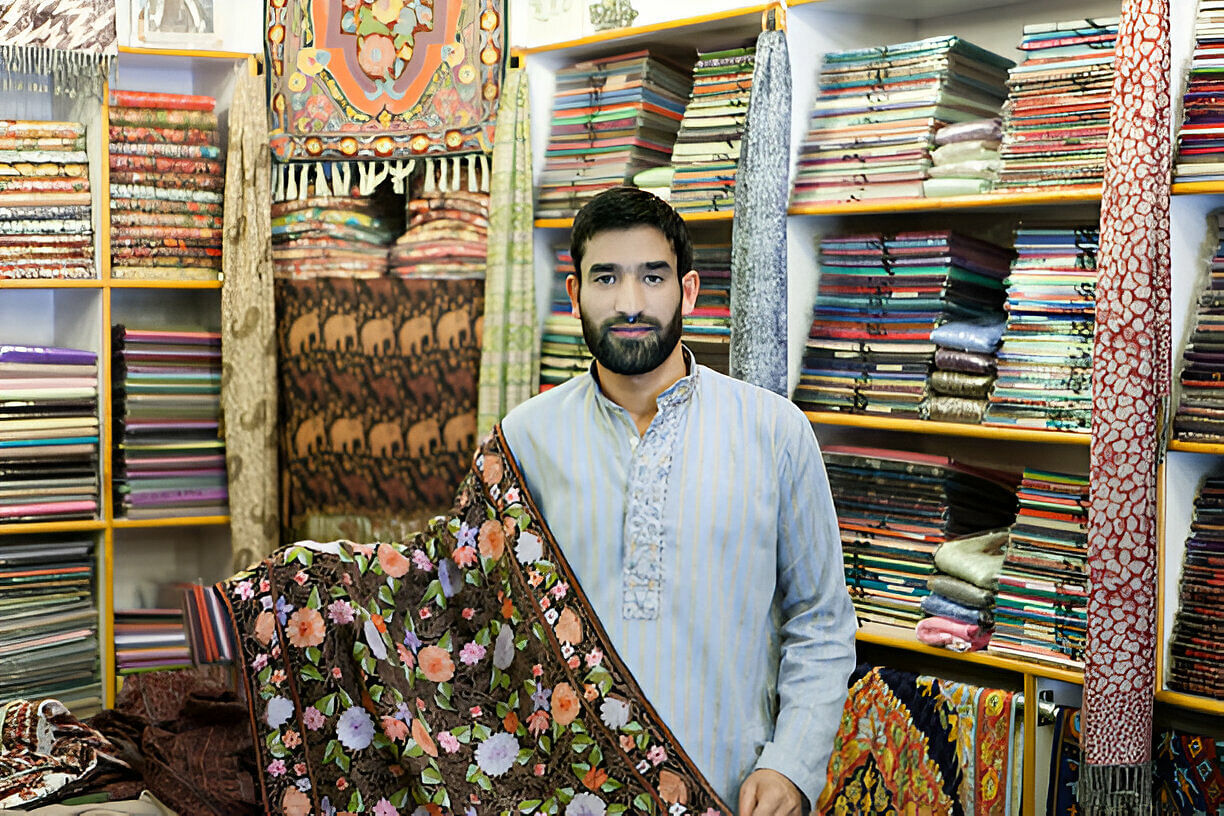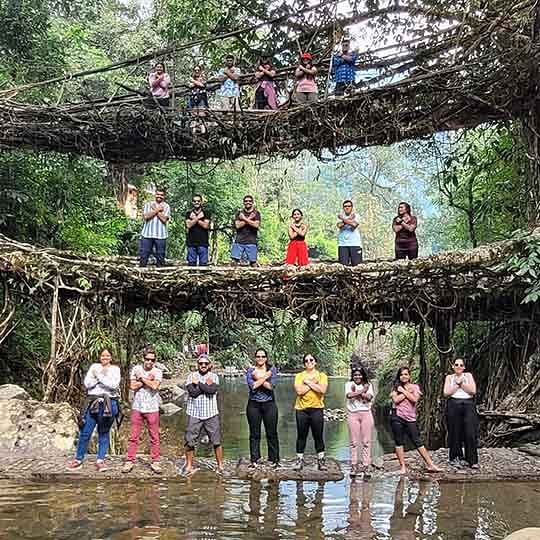Kashmiri handicrafts have a magic that photographs cannot do justice to. You need to hold them in your hands to understand their beauty.
When you go to the craft villages near Srinagar, you will never stop being amazed watching these families work – some using the same tools their great-grandparents used! How they transform raw wool into those unbelievably soft pashmina shawls is unbelievable.
Among all the places to see in Kashmir, the old bazaars should be on your list. Haggling for a box made of walnut wood or a papermâché bowl became one of the highlights of our journey.
Our Kashmir tour packages will bring you to the most popular sites. You have to go to the small workshops. That's where you'll find the true treasures. And really, one of the best things to do in Kashmir is just to sit with a craftsman, have some kahwa tea, and observe them work. You'll take home stories, not souvenirs.
History of Handmade Kashmiri art and craft
The history of a few centuries indicates that Kashmir handicrafts products developed after diverse cultures affected the state due to its location on significant trade routes. The cultural influences converged into new arts, which identify Kashmir's art legacy. Mughal periods contributed vitally by propagating handicrafts as Central Asian artisans combined with Persia introduced new crafts and aesthetic details. Various outside cultural elements blended with local traditions over several centuries to create what we know as the contemporary Kashmir arts and crafts tradition.
Importance in Kashmiri Culture
Traditional Kashmiri handicrafts maintain a central place within Kashmiri customs and regular activities of their culture. Multiple Kashmir crafts function as vital elements for various spiritual beliefs as well as traditional ceremonies. The abstract patterns on Pashmina shawls and carpets derive their inspiration from nature because Kashmiri people maintain an intense relationship with their natural environment. The motifs featured on Kashmiri wooden handicrafts, together with papiermâché items, convey meanings about prosperity and fertility and protective aspects that signify their cultural standing.
Suggested Read: Nigeen Lake Vs Dal Lake
Economic Importance of Kashmir handloom and handicrafts
The handicraft sector functions as Kashmir's economic foundation because it provides employment opportunities to numerous people. Due to their involvement with Kashmir handicrafts products, artisans generate large amounts of income, which stems from both local markets and international export sales. Thousands of families in Kashmir have maintained their existence through the years because of global interest in genuine Kashmiri products, including Pashmina shawls and handknotted carpets. Handicrafts empower female workers through the opportunity to conduct spinning, weaving, and embroidery tasks from their home bases.
Detailed Exploration of Kashmiri Handicrafts
The wool used to create Pashmina, which locals call the "soft gold," comes from the Himalayan Changthangi goats residing in mountainous regions. Pashmina follows the common classification of cashmere wool. The production of Pashmina shawls demands extensive labor and a long duration of time to complete the following steps:
- Natural shedding of goat coats during their spring molting season are when collectors retrieve the wool.
- First, the wool gets cleaned from impurities before craftsmen derive fine yarn using traditional spinning tools called Yinder.
- Women weavers with weaving expertise access traditional looms to produce one-off handmade shawls from their handspun yarn.
- Multiple Pashmina shawls receive aesthetic enhancements from the traditional Kashida embroidery work.
- Global markets greatly desire Pashmina shawls because of their premium quality and clean softness, combined with elegant design patterns.
People have recognized Kashmiri carpets under the name 'Kaleen' for their detailed patterns combined with exceptional handiwork. During the Mughal period, the artisans introduced this artisanal craft into Kashmir where they used:
- Materials: High-quality wool, silk, or a blend of both.
- The creators use handknotting techniques to develop detailed patterns through exact knotting procedures.
Seven-handled knives have designs that combine floral motifs and geometric patterns with natural motifs that showcase Kashmir's rich artistic heritage. A single handmade carpet takes an extended duration of between months and years for completion because of its dimensions and design difficulties.
Kashmiri artisans display their artistic talent through papiermâché, which remains a traditional craft in Kashmir. The process involves:
- The initial step involves paper saturation in water until complete disintegration happens before combining the pulp with adhesive solutions.
- Artists fashion the pulp material into vases and boxes as well as decorative figures by using their hands.
- The dried items receive careful handpainting treatment featuring floral patterns along with bright colors.
Through this sustainable process, people create decorative items while practicing waste paper recycling.
Suggested Read: Kashmir Travel Guide
Kashmir is one of the few places where the walnut tree, known for its dense and durable wood, grows abundantly. Kashmiri wooden handicrafts made from walnut wood are prized for their:
- The solid structure of walnut wood creates durable systems that last many years, thus making it suitable for furniture and decorative artwork.
- Traditional wooden furniture gains enhanced attractiveness because of its beautiful naturally occurring grain patterns.
- Artisans develop complicated designs by carving out traditional symbols together with chinar leaves and lotus flower motifs.
Products range from furniture items like tables and chairs to smaller decorative pieces such as jewelry boxes and trays.
The flexible style of embroidery known as crewel embroidery depends on wool thread, which works on cotton, silk, or linen fabric. Characteristics include:
- Embroiderers use various stitches to develop textured patterns on the raised surface.
- Embroiderers regularly source their designs from natural themes that include flowers as well as vines and animal illustrations.
- Household objects, including curtains, cushion covers, and bedspreads, receive their decorative touch from this embroidery style.
The Kashmiri town of Sozni houses the most exquisite, delicate form of embroidery within all of Kashmir. People usually use Sozni embroidery to decorate Pashmina shawls as well as woolen and silk fabrics. Artisans use thin needles as well as silk or cotton thread to develop their paisley and floral patterns.
- The fabric receives embroidery treatment on both its sides, which results in the design's uniformity across the front and back surfaces.
- The main motifs featured in these pieces are floral designs combined with chinar leaf motifs and Mughal-patterned details and vines.
- The completion process for single pieces of shawls or stoles takes months due to the small and complicated nature of their stitches.
Sozni embroidery adds elegance to Kashmir handloom and handicrafts, making them highly valuable in both Indian and international markets.
Kashmir stands as the origin of Tilla embroidery, which represents a regal, luxurious style of embroidery work. Historically speaking, this decorative method adorns bridal outfits and pherans and shawls.
- Embroidered with gold and silver metallic threads, the fabric becomes majestic in appearance.
- Special festive occasions and weddings prompt the display of Tilla embroidery, which appears on velvet, silk, and wool garments.
- Traditional Motifs in the designs consist of Mughal patterns with floral designs and paisleys.
This embroidery is passed down through generations, with many families specializing in the craft for centuries.
Under the felting technique, Namda traditional woolen rugs receive their form instead of the conventional weaving approach. Produced in Kashmiri homes, Namda rugs earn popularity because of their gentle texture and colorful needlework.
- Making Namda requires wool processing by beating and pressing the wool through water combined with soap. Crafters apply hand embroidery to felt wool, which receives bright colors during the dyeing process.
- Residents and visitors identify Namda rugs primarily for their floor application and their function as prayer mats as well as decorative pieces.
Due to their affordability and warmth, Namda rugs have gained popularity in various parts of India and abroad.
Suggested Read: Backpacking Trip to Kashmir
9. Chain Stitch & Crewel Work
The two chief embroidery techniques utilized in home furnishings include chain stitch and crewel embroidery, which are applied to cushion covers, wall decorations, and rugs.
- Making chain stitch possible through hookwork with an Aari tool proves faster than traditional embroidery methods. Embroidery designs include both floral motifs and bird and animal depictions. Embroiderers use this technique to create wall decorations and produce both bags and pillowcases.
- The fabric mixture of wool threads applied on cotton or velvet fabric represents Crewel Embroidery. The material achieves texture elevation through this technique to suit decoration items for homes.
These embroidery styles are essential parts of Kashmir arts and crafts, showcasing the region's aesthetic excellence and creativity.
The Role of Kashmiri Handicrafts in Tourism
Kashmir is known as "Paradise on Earth", and its handicrafts attract tourists from all over the world.
- Visible showcases of historical Kashmiri handicrafts are available at bazaars in three prime areas: the Floating Market in Srinagar, along with Polo View and Lal Chowk, to draw tourist shoppers.
- Visitors frequently visit workshops for two reasons: they learn about Pashmina weaving and walnut wood carving and papiermâché techniques.
- Websites affiliated with e-commerce facilitate the international flow of Kashmiri handicraft products to global consumers.
These traditional crafts contribute significantly to Kashmir’s tourism industry and economy.
Suggested Read: Hidden Places in Srinagar
Challenges Faced by Kashmiri Artisans
Despite the popularity of Kashmir arts and crafts, artisans face several challenges:
1. Machine-Made Replicas: The market contains excessive machine-made Pashmina shawls together with imitation Kashmir craft goods, making it challenging for artisans to sell their genuine handmade pieces to customers.
2. Declining Number of Artisans: Youth workers avoid working in handicrafts because wages in the sector remain low.
3. Lack of Government Support: The artisan sector faces difficulties because the government fails to offer substantial financial backing and has inadequate marketing platforms.
4. Political & Environmental Issues: The production and sales operations of Pashmina shawls suffer from frequent regional conflicts and severe winter weather conditions.
To preserve Kashmir handloom and handicrafts, more awareness, government initiatives, and direct support to artisans are needed.
Preservation & Future of Kashmiri Handicrafts
To ensure the survival of Kashmiri wooden handicrafts, textiles, and embroidery arts, several steps are being taken:
- GI Tag Certification: Genuine Pashmina shawls and Kashmiri carpets obtained GI Tag Certification as Geographical Indication labels to authenticate their authenticity.
- E-commerce Platforms: Artisans are leveraging Amazon together with Flipkart as well as Etsy to sell their handmade products worldwide through these e-commerce platforms.
- Craft Fairs & Exhibitions: Artisans sell through craft events organized as Delhi Haat and Surajkund Mela, among others.
- Training Young Artisans: Through educational programs, multiple organizations pass on traditional artisan skills to young people who will preserve the craft tradition.
With the right initiatives, Kashmiri handicrafts can continue to flourish and reach new heights globally.
Suggested Read: Shopping in Gurez
Kashmiri Handicrafts represent centuries of tradition, skill, and dedication. From luxurious Pashmina shawls to handcarved walnut wood furniture, each piece is a testament to the artistic excellence of Kashmiri artisans. Despite facing modern challenges, these crafts continue to thrive through global appreciation and evolving market trends.
By supporting handmade Kashmiri art and craft, we can preserve this rich heritage, support artisans, and celebrate Kashmir’s cultural legacy.








